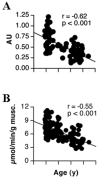Mitochondrial DNA alterations and reduced mitochondrial function in aging
- PMID: 20307565
- PMCID: PMC2910809
- DOI: 10.1016/j.mad.2010.03.007
Mitochondrial DNA alterations and reduced mitochondrial function in aging
Abstract
Oxidative damage to mitochondrial DNA increases with aging. This damage has the potential to affect mitochondrial DNA replication and transcription which could alter the abundance or functionality of mitochondrial proteins. This review describes mitochondrial DNA alterations and changes in mitochondrial function that occur with aging. Age-related alterations in mitochondrial DNA as a possible contributor to the reduction in mitochondrial function are discussed.
Copyright 2010 Elsevier Ireland Ltd. All rights reserved.
Figures




References
-
- Anderson S, Bankier AT, Barrell BG, de Bruijn MH, Coulson AR, Drouin J, Eperon IC, Nierlich DP, Roe BA, Sanger F, Schreier PH, Smith AJ, Staden R, Young IG. Sequence and organization of the human mitochondrial genome. Nature. 1981;290:457–65. - PubMed
-
- Aniansson A, Hedberg M, Henning GB, Grimby G. Muscle morphology, enzymatic activity, and muscle strength in elderly men: a follow-up study. Muscle Nerve. 1986;9:585–91. - PubMed
-
- Anson RM, Hudson E, Bohr VA. Mitochondrial endogenous oxidative damage has been overestimated. Faseb J. 2000;14:355–60. - PubMed
Publication types
MeSH terms
Substances
Grants and funding
LinkOut - more resources
Full Text Sources
Medical

